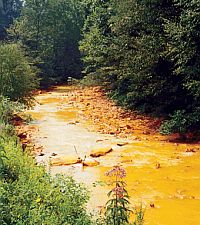Methods/Indicators For Determining When Metals Are The Cause Of Biological Impairments Of Rivers And Streams: Species Sensitivity Distributions And Chronic Exposure-Response Relationships From Laboratory Data
Alert
Notice
This final report details the methodology for statistical analysis of data on metals toxicity to aquatic organisms and application of analysis results to Stressor Identification. There are 12 appendices which accompany the report to provide source data along with graphical and tabular output.
Due to the size and complexity of these appendices - they are not coded for accessibility. If you need help with these attachments, please phone 513-569-7598 or email the NCEA Technical Information Unit (TIU) of Cincinnati for assistance.
Abstract
This final report describes an analysis of data on the toxicity of metals to aquatic organisms in laboratory toxicity tests and how to apply this information in a Stressor Identification Assessment. Results are provided in the form of species sensitivity distributions (SSDs) and concentration-response relationships for individual aquatic species. Over a thousand water bodies in the United States are listed by states as biologically impaired. For many of these, the cause of the impairment is also reported as unknown. Before an appropriate management action can be formulated, the cause of the biological impairment must be determined. The U.S. Environmental Protection Agency Stressor Identification Process (U.S. EPA, 2000) is a formal method for identifying causes of such impairments. Defensible causal analyses require knowledge of the mechanisms, symptoms, and stressor-response relationships for various specific stressors as well as the ability to use that knowledge to draw appropriate conclusions.
Over a thousand water bodies in the United States are listed by states as biologically impaired. For many of these, the cause of the impairment is also reported as unknown. Before an appropriate management action can be formulated, the cause of the biological impairment must be determined. The U.S. Environmental Protection Agency Stressor Identification Process (U.S. EPA, 2000) is a formal method for identifying causes of such impairments. Defensible causal analyses require knowledge of the mechanisms, symptoms, and stressor-response relationships for various specific stressors as well as the ability to use that knowledge to draw appropriate conclusions.
This report provides information on the effects of metals on laboratory animals which may be used in the strength-of-evidence step of the Stressor Identification (SI) Process to help determine whether metals contribute to biological impairments.
Impact/Purpose
This report describes an analysis of data on the toxicity of metals to aquatic organisms in laboratory toxicity tests and how to apply this information in a Stressor Identification Assessment.Status
This is the Final report.Citation
U.S. EPA. Methods/Indicators For Determining When Metals Are The Cause Of Biological Impairments Of Rivers And Streams: Species Sensitivity Distributions And Chronic Exposure-Response Relationships From Laboratory Data. U.S. Environmental Protection Agency, Washington, DC, EPA/600/X-05/027, 2005.History/Chronology
| Date | Description |
|---|---|
| 01- Mar 2005 | External review of the draft document. |
| 02- July 2005 | Completion of the final document. |
| 03- Jan 2008 | EPA releases the final document. |
| 04- TBD | Electronic SSD and Exposure Response Library loaded to CADDIS |
Additional Information
This report is also referenced in the Listing Metals as a Candidate Cause section of the CADDIS Web site. The CADDIS website includes an electronic indexed gallery of SSDs and source data along with an SSD Generator spreadsheet that can be used to reanalyze the data. The chronic concentration-response relationships included in this report are also provided as an electronic indexed gallery with source data that can be reanalyzed using the CADStat.Download(s)
This document has been reviewed in accordance with U.S. Environmental Protection Agency policy and approved for publication. Mention of trade names or commercial products does not constitute endorsement or recommendation for use.
- Methods/Indicators for Determining when Metals are the Cause of Biological Impairments of Rivers and Streams: Species Sensitivity Distributions and Chronic Exposure-Response Relationships from Laboratory Data (PDF) (60 pp, 1.2 MB, about PDF)
- APPENDIX A: ECOTOX CODING, DATA, AND CITATIONS (PDF) (744 pp, 11.9 MB, about PDF)
- APPENDIX B: ARTHROPOD SPECIES SENSITIVITY DISTRIBUTIONS (PDF) (66 pp, 662.1 KB, about PDF)
- APPENDIX C: NON-ARTHROPOD INVERTEBRATE SPECIES SENSITIVITY DISTRIBUTIONS (PDF) (73 pp, 716.8 KB, about PDF)
- APPENDIX D: INVERTEBRATE SPECIES SENSITIVITY DISTRIBUTIONS (PDF) (155 pp, 1.6 MB, about PDF)
- APPENDIX E: VERTEBRATE SPECIES SENSITIVITY DISTRIBUTIONS (PDF) (166 pp, 2.0 MB, about PDF)
- APPENDIX F: COMPARISON OF ARTHROPOD AND NON-ARTHROPOD INVERTEBRATE SPECIES SENSITIVITY DISTRIBUTIONS (PDF) (17 pp, 244.1 KB, about PDF)
- APPENDIX G: COMPARISON OF HARDNESS EFFECT ON SPECIES SENSITIVITY DISTRIBUTIONS (PDF) (53 pp, 713.9 KB, about PDF)
- APPENDIX H: COMPARISON OF TEMPERATURE EFFECT ON SPECIES SENSITIVITY DISTRIBUTIONS (PDF) (38 pp, 468.8 KB, about PDF)
- APPENDIX I: COMPARISON OF DURATION EFFECT ON SPECIES SENSITIVITY DISTRIBUTIONS (PDF) (63 pp, 805.7 KB, about PDF)
- APPENDIX J: EXPOSURE RESPONSE MODELING WITH CHRONIC TOXICITY DATA (PDF) (39 pp, 477.5 KB, about PDF)
- APPENDIX K: INTERPOLATED EXPOSURE RESPONSE RELATIONSHIPS (PDF) (119 pp, 1.1 MB, about PDF)
- APPENDIX L: EXPOSURE RESPONSE OUTPUT AND DATA TABLES (PDF) (38 pp, 1.1 MB, about PDF)
